Levitating into the Future
Business been taken care of the night before. But the unpleasant repercussions were just beginning this morning in the newsroom.
"Your eyes are an especially deep shade of red this morning," she said.
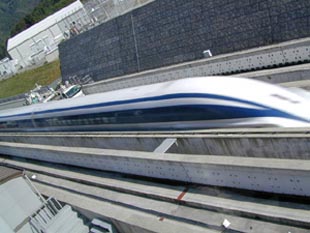 "It was a hard negotiation session," I assured. I slapped my head into my right palm and dropped the set onto my desk.
"It was a hard negotiation session," I assured. I slapped my head into my right palm and dropped the set onto my desk.
"What sort of negotiation?" she demanded, leaning over. I knew this because her voice had become louder.
I pivoted my head upward. "Volume," I muttered. "Volume business always warrants a discount."
The emergence of a new convenience store in my neighborhood necessitates a visit with the manager before the grand opening for a little agreement as to alcohol and tobacco purchases. Junior reporter Junko can sometimes be a little naive when it comes to the nuts and bolts of the business world.
"Whatever the specifics," she added, "it obviously involved placing priority on satisfying your alcoholic urges over finishing the magnetic levitation train story, right?"
I slowly shook my head - not to acknowledge the question, but rather in disgust to the sad fact that such feeble character attacks are a standard part of the news business. The report was out of my drawer and into her hands before she could cast comment on the stack of porno comics at the edge of my desk.
Fast. This train is fast. After reaching a certain speed, it literally floats on a magnetic field, becoming frictionless with the track. Fast, floating, and frictionless. Super, you might say. Actually, it is superconductivity.
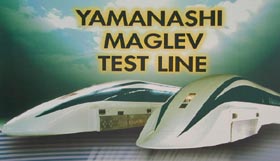 All aboard the Maglev (from "magnetic levitation"), the revolutionary train technology in which the cars float above the track with the assistance of magnets and electricity. Does this sound like an upcoming ride at Disneyland? It's not. Instead it might actually just be the future of train travel.
All aboard the Maglev (from "magnetic levitation"), the revolutionary train technology in which the cars float above the track with the assistance of magnets and electricity. Does this sound like an upcoming ride at Disneyland? It's not. Instead it might actually just be the future of train travel.
Though in mere testing stages now at a specially prepared track in Yamanashi Prefecture, train travel using this cutting-edge technology might just supplant the airplane and the Tokaido Shinkansen "bullet" train as the preferred means for passengers to travel from Tokyo to Osaka and back. But before such an implementation can take place, the Maglev's astronomical construction, operating, and potential environmental costs will have to be overcome. In the meantime, the testing track presents a chance for techno geeks, rail fans, and average thrill seekers to get a firsthand look at where train travel might be headed - an experience that is not too far removed from that of an amusement park attraction.
Typically when one thinks of Yamanashi Prefecture, grape farming, or perhaps wine, first comes to mind. In fact, many areas of the countryside surrounding JR Otsuki Station - with Mt. Fuji looming in the backdrop - are filled with many small farming plots. But these days, things might be changing a bit; just a few kilometers down the Chuo Expressway from the station, the Maglev train testing track is making speed a much talked about commodity in prefecture as well.
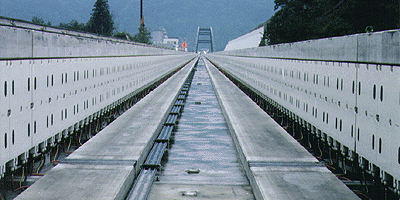 Here, the testing track is formed by two elevated parallel chutes (known officially as "guideways") of concrete that extend for 18 kilometers along the countryside and through tunnels within the mountains. The Maglev Exhibition Center - an information center with an observation room that gives the best location to view the action - sits roughly at the midpoint, next to the track's large steel support arch that extends across the expressway below. As the trains fly past during their test runs, the farmers below can hear the thunderous roars.
Here, the testing track is formed by two elevated parallel chutes (known officially as "guideways") of concrete that extend for 18 kilometers along the countryside and through tunnels within the mountains. The Maglev Exhibition Center - an information center with an observation room that gives the best location to view the action - sits roughly at the midpoint, next to the track's large steel support arch that extends across the expressway below. As the trains fly past during their test runs, the farmers below can hear the thunderous roars.
Just how fast are they moving? In one test run in 1999, a train with 13 passengers and a payload of 10 tons, set a new world record of 552 kilometers per hour (kph). A French TGV train holds the conventional train record of 515 kph. For reference, the Tokaido Shinkansen's fastest train travels at a top speed of 300 kph. It was this speed record that put Japan's Maglev program at the center of the world's technological stage.
Each train is composed of three to five white and blue cars with the front and rear cars shaped like large duckbills at their ends. There are actually two designs for these end cars: the needle-nosed "double cusp" type and the more rounded "aero wedge." Interior cabin walls are curved and smooth, resembling that of an airplane. Seats are a spacious four across in each row. There are no seatbelts.
A quick inspection of the Maglev track reveals the main difference between this technology and that of standard electric trains in Tokyo or any other big city: there are no overhead electrical lines. Instead, superconducting magnets (about the length and width of a small hall carpet) installed in the sidewalls of the train and electrical coils buried within both sides of the U-shaped guideway team up to provide the train's source of power and navigation.
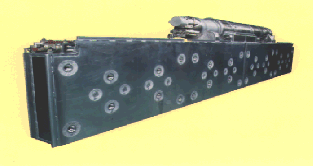 These are not just any ordinary magnets. Superconducting magnets, when combined with electricity, can create electromagnetic forces with little loss of energy. Thus, when alternating electrical current from power substations strategically placed along the track is pumped into the electrical coils, the interaction with the onboard superconducting magnets produces electromagnetic forces that propel and guide the train. After a certain speed is reached, the forces become such that levitation (roughly the thickness of a phonebook above the track) of the vehicle occurs. Drivers are not needed as a remote computer-controlled command center regulates the electric current through the coils and, as a result, the speed of the train.
These are not just any ordinary magnets. Superconducting magnets, when combined with electricity, can create electromagnetic forces with little loss of energy. Thus, when alternating electrical current from power substations strategically placed along the track is pumped into the electrical coils, the interaction with the onboard superconducting magnets produces electromagnetic forces that propel and guide the train. After a certain speed is reached, the forces become such that levitation (roughly the thickness of a phonebook above the track) of the vehicle occurs. Drivers are not needed as a remote computer-controlled command center regulates the electric current through the coils and, as a result, the speed of the train.
Though this might sound like a technology that could only be from the modern age, superconducting magnets were first studied for use in train propulsion 40 years ago. In 1972, Japan constructed its first test Maglev vehicle. Until today, the difficulty had always been in effectively harnessing electromagnetic currents. This is something that Japanese engineers believe they have finally done.
Testing in Yamanashi Prefecture began in 1997. The Central Japan Railway Co. (JR Tokai) and the Railway Technical Research Institute in Kunitachi, Tokyo are performing the testing together as a joint operation.
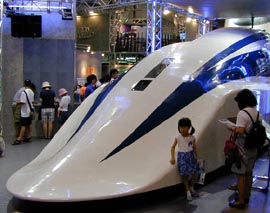 The testing is needed to work out various technical kinks. Given the fact that this technology would be operating essentially without precedent, the train must demonstrate a high degree of safety, reliability, and efficiency under a number of different operating scenarios before its implementation.
The testing is needed to work out various technical kinks. Given the fact that this technology would be operating essentially without precedent, the train must demonstrate a high degree of safety, reliability, and efficiency under a number of different operating scenarios before its implementation.
But sixty percent of the train's test track has yet to be constructed. It will take these additional track lengths before the train can complete the necessary tests. Estimates reveal that completion of these tests could still be many years off. Yet, this is only one of the potential hurdles in getting the Maglev off the ground.
Proponents of establishing a Chuo Shinkansen (the name to be given to the Maglev line stretching between Tokyo and Osaka) have high hopes for the potential positive outcomes.
JR Tokai executive Chuji Morishita, in a recent article in the Japan Times, said of the Maglev in reference to Japan's 10-year economic slump and political leadership vacuum, "The inauguration of the Maglev will break Japan's stagnation, both politically and economically."
Additionally, literature at the Maglev Exhibition Center indicates that implementation of the Maglev will also do such things as promote cultural relationships, expand tourism, and provide some kind of"harmony with nature" for Tokyo, Osaka, and the 7 prefectures that lie in the line's path.
This remains to be seen. But before the Maglev can pull from the station even once, it is going to have to overcome a number of significant difficulties.
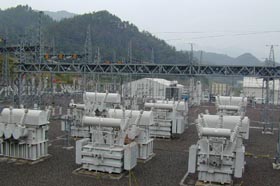 The first is the staggering 8 trillion yen construction cost. In comparison to Shinkansen lines, Maglev track costs 20% more to construct. Operational costs are roughly double. Then there is the massive land acquisition and the associated environmental problems due to the tunneling and infrastructure work. Add to this the large subterranean areas beneath urban centers that will need to be properly secured, and a monstrous task awaits.
The first is the staggering 8 trillion yen construction cost. In comparison to Shinkansen lines, Maglev track costs 20% more to construct. Operational costs are roughly double. Then there is the massive land acquisition and the associated environmental problems due to the tunneling and infrastructure work. Add to this the large subterranean areas beneath urban centers that will need to be properly secured, and a monstrous task awaits.
Backers point to the fact that the Maglev will cut the travel time between Tokyo and Osaka from the current two and a half hours by Tokaido Shinkansen to around 60 minutes. Depending on ticket prices, passenger demand, and airline competition, the shorter travel time could translate into a greater passenger capacity and larger revenue.
This would be a far cry from what travelers of the Edo Period (1603-1868) endured. They covered this same distance in 15 days by horse and cart. By 1964 travel had improved considerably when the Tokaido Shinkansen started operation, accommodating 11 million passengers that year. This total mushroomed to over 130 million by the late '90s.
But will there be the necessary demand for the Maglev? Large increases in passenger travel on the Tokaido Shinkansen took place in the early '80s. This was when the first true plans for such a Chuo Shinkansen line took hold. But the number of annual travelers has not been increasing beyond 130 million in recent years. Additionally, Japan's birthrate has declined to its lowest rates in history and its economy is showing no signs of recovery.
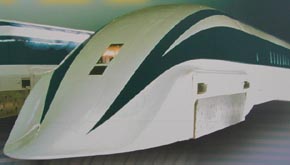 Isn't there then a chance that Japan's version of the Concorde might simply turn into a giant levitating tax burden for future generations? Germany thought so. They scrapped their proposed Maglev line between Berlin and Hamburg in 2000 due to the high costs and a lack of passenger demand.
Isn't there then a chance that Japan's version of the Concorde might simply turn into a giant levitating tax burden for future generations? Germany thought so. They scrapped their proposed Maglev line between Berlin and Hamburg in 2000 due to the high costs and a lack of passenger demand.
Anthony Robins, an organizer and guide for train tours with the Japan Railway Society, an organization that promotes knowledge of Japan's railways, sees the potential advantages of the Maglev over the existing Tokaido Shinkansen as being enough to make the project favorable. "There is a temptation to say that so much has already been spent that it would be a waste not to go forward with Maglev," he says. "From the tax point of view, for me, the controversial expressway building program is a greater drain on public money."
The drain he is referring to has been extraordinary. Hundreds of billions of dollars have been spent on road and bridge projects over the past decade in Japan. It has been a way to funnel the wealth from Tokyo to remote areas of the country and create jobs. But the projects have been mostly unnecessary and wasteful, resulting mainly in mountains of debt. With this sort of spending on transportation infrastructure as a precedent - and an assumption that it will continue, the reality of a Chuo Shinkansen might not be all that far-fetched.
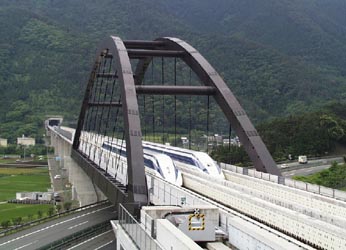 Outside of Japan, plans for Maglev trains are beginning to roll in some countries. By the end of this year, a Maglev system extending for 20 miles is set to be up and running in Shanghai. And the United States is looking to invest nearly $1 billion for the construction of such a system in a location to be determined by the Department of Transportation.
Outside of Japan, plans for Maglev trains are beginning to roll in some countries. By the end of this year, a Maglev system extending for 20 miles is set to be up and running in Shanghai. And the United States is looking to invest nearly $1 billion for the construction of such a system in a location to be determined by the Department of Transportation.
A few years ago, Japanšs Maglev program nearly died. With budgets for the project drying up in the late '90s, the future of the Maglev appeared in limbo and the construction of the remaining portion of the testing track uncertain. But the program received a boost when a 100 million yen budgetary allotment for research was created by the Ministry of Finance for fiscal 2000. For now, all systems are go with testing taking place year round and special rides being offered to the public periodically.
Getting a chance to test ride the Maglev has been a hot ticket. After the announcement of a testing date, prospective riders must mail in a postcard to enter a drawing. Over a dozen tests have been offered with the odds of getting a seat sometimes being less than 1 in 100. Since riding the Maglev was opened to the public in 2000, celebrities, foreign dignitaries, and even Japanese astronauts have all experienced the speed.
Each test begins with the train slowly pulling from the station at the Maglev Exhibition Center. A digital readout of the train's speed at the front of each car acts as a scoreboard for test riders to follow as the train progresses through the course of the test. Between 130 and 160 kph, the wheels fold up within the carriage and the levitation begins. Though not loud to begin with, the rumbling of the wheels stops after contact is lost. The only sound now is the chatter of the riders anticipating more speed.
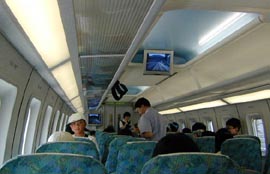 Outside the windows, riders can catch a quick glimpse of farms and farmers as the train hurtles past, continuing to pick up speed. Then it is into a tunnel. More speed. 395 kph. Ears pop and some test riders let out muffled screams. 440 kph. The walls of the cabin shake and the car rattles, though not too noticeably. The train holds at 450 kph - the top speed for this test - for a few moments while lights mounted on the tunnel walls fly past the windows, giving the effect of film frames moving past a series of projectors. Then there is a gradual slowdown to a stop, from where another run begins in reverse. Total test time: about 20 minutes.
Outside the windows, riders can catch a quick glimpse of farms and farmers as the train hurtles past, continuing to pick up speed. Then it is into a tunnel. More speed. 395 kph. Ears pop and some test riders let out muffled screams. 440 kph. The walls of the cabin shake and the car rattles, though not too noticeably. The train holds at 450 kph - the top speed for this test - for a few moments while lights mounted on the tunnel walls fly past the windows, giving the effect of film frames moving past a series of projectors. Then there is a gradual slowdown to a stop, from where another run begins in reverse. Total test time: about 20 minutes.
Though taking a ride can be enjoyable, convincing test riders of the value of the Maglev as a reasonable form of travel might be more than backers had bargained for.
"Do normal people like me use the Concorde even if it is a faster means of travel?" asks Maiko Ochiai, a 26-year old test rider. "No way. It is way too expensive. The Maglev will be transportation for corporate people and rich folks."
Note: Photos 3,4, and 8 courtesy of the Railway Technical Research Institute.

